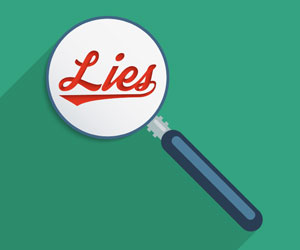Response Times Do Not Imply Accurate Unconscious Lie Detection
 In research published in Psychological Science in 2014, psychological scientists Leanne ten Brinke and colleagues presented studies suggesting that people are able to detect lies on an unconscious level even if they can’t detect them consciously. But, in a new commentary published in Psychological Science, researchers Volker Franz and Ulrike von Luxburg examine the classification accuracy of the original data and find no evidence for accurate unconscious lie detection.
In research published in Psychological Science in 2014, psychological scientists Leanne ten Brinke and colleagues presented studies suggesting that people are able to detect lies on an unconscious level even if they can’t detect them consciously. But, in a new commentary published in Psychological Science, researchers Volker Franz and Ulrike von Luxburg examine the classification accuracy of the original data and find no evidence for accurate unconscious lie detection.
ten Brinke and colleagues had participants watch videos of “suspects” in a mock-crime interview. Half of the suspects had actually stolen a $100 bill from a bookshelf, half had not, but all of the suspects were instructed to tell the interviewer they had not stolen the money. This meant that half of the suspects were definitely lying and the other half were definitely telling the truth.
When participants were asked to indicate whether each suspect was lying or telling the truth, they were essentially at chance-level, indicating that they were not able to consciously detect deceit.
The researchers also employed widely-used behavioral reaction time tests (one of which is called the Implicit Association Test or IAT) to probe participants’ more automatic responses in relation to the suspects.
The participants were asked to classify different words, such as “deceitful” or “honest,” into the appropriate category, either “lie” or “truth.” Before each word, the participants were very briefly presented with a photo of a suspect – the presentation was so brief that the participants were not aware they had seen the photo.
The results showed that participants were faster at classifying words when they matched up with the suspects – that is, they were faster at categorizing words like “honest” when they had been shown a picture of an innocent suspect and were faster at categorizing words like “deceitful” when they were preceded by a picture of a guilty suspect.
In their paper, ten Brinke and colleagues interpret these results as evidence that “viewing a liar automatically and unconsciously activates deception-related concepts, and viewing a truth teller activates truth concepts.” This pattern “supports our hypothesis that indirect measures of deception detection demonstrate greater accuracy than direct self-reports, which have dominated past research,” the researchers conclude.
However, Franz and von Luxburg argue that faster classification of words does not imply that the underlying lie-detection processes are accurate – that is, the reaction times are not necessarily useful for classifying individual suspects as guilty or innocent.
To demonstrate this, Franz and von Luxburg re-analyzed the original data, testing different reaction times as possible classification thresholds. If a reaction time is below the threshold (i.e., faster), it would signify that the suspect and the word matched – that is, a guilty suspect was presented before a deception-related word, or an innocent suspect was presented before a truth-related word. If a reaction time is above the threshold (i.e., slower), it would signify that a mismatch between prime and target occurred.
Testing different thresholds, the researchers found that classification accuracy was always close to chance level.
To explain these results, the researchers draw an analogy to a more intuitive example: classifying adults as male or female based on their weights. Because there is quite a bit of overlap in the distribution of weights between men and women, classification accuracy would be poor. But a comparison of the mean weights of the two groups would indicate that men weigh more than women.
“This shows how a significant difference can coexist with essentially chance-level classification accuracy and that good classification accuracy of the individual adults cannot be inferred from the fact that the group means are significantly different,” Franz and von Luxburg write.
“We have shown that – no matter how we aggregated the individual trials from ten Brinke et al. – the RT distributions of liars and truth tellers always overlapped so heavily that no good classification could be obtained,” they conclude.
When invited to submit a rebuttal to the commentary for review, ten Brinke and colleagues replied: “We appreciate the opportunity to respond to this Commentary but will respectfully decline. We hope that methodological and mathematical experts will take up this conversation to refine the methods available for comparing conscious and nonconscious classification in the future.”
References
Franz, V.H., & von Luxburg, U. (2015). No evidence for unconscious lie detection: A significant difference does not imply accurate classification. Psychological Science. DOI: 10.1177/0956797615597333
ten Brinke, L., Stimson, D., & Carney, D. (2014). Some evidence for unconscious lie detection. Psychological Science, 25 (5), 1098-1105. DOI: 10.1177/0956797614524421



APS regularly opens certain online articles for discussion on our website. Effective February 2021, you must be a logged-in APS member to post comments. By posting a comment, you agree to our Community Guidelines and the display of your profile information, including your name and affiliation. Any opinions, findings, conclusions, or recommendations present in article comments are those of the writers and do not necessarily reflect the views of APS or the article’s author. For more information, please see our Community Guidelines.
Please login with your APS account to comment.